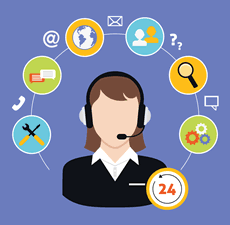
A Corizon poll investigated which communication channels British consumers prefer and those that contact centers offer. The resulting research has revealed demographic preferences for various contact methods.
The findings also raise questions about how contact centers are coping with the increased number of contact channels and whether they’re able to private a multi-channel and omni-channel customer service in this context.
Corizon, a UK-based provider of contact center solutions, polled 2,127 consumers in collaboration with YouGov and carried out a simultaneous survey of 90 contact center managers to find out about the traditional and new contact and customer service channels they handled…and how they handled those channels.
How people seek customer service – and get it
When asked how they would contact a company for customer, billing or support enquiries, consumers chose across a range of eight contact channels.
Phone was the most popular channel, selected by 75% of respondents, followed by email (70%), web self-service (43%), letters (31%), social media such as Twitter or Facebook (4%), fax (3%) and SMS (3%).
When asked which contact channels they supported, the responses from contact center managers – obviously – showed that phone was the most supported interaction channel here as well, with 100 per cent support for phone queries.
96% provided email support, 90% handled customer requests by letter, 65% offered web self-service, 27% supported SMS requests, 20% handled social media such as Twitter, online forums or Facebook, and 11% offered IM and online chat support. In other words: although social channels and new digital ways of seeking and providing support (except for email and web self-service) are far from omnipresent in contact centers, the percentage of supported social and mobile channels is higher than the actual way consumers use them to seek support.
The integrated and omnichannel challenge
Still, there are quite some challenges before contact centers can provide a true omni-channel customer service with a single customer (history) view. If we know that, increasingly people expect service across various channels, these is even more true.
Over half (59%) of contact center managers said that their agents were expected to handle different contact channels simultaneously. Over a fifth (22%) said agents were expected to handle different channels, but on separate shifts.
75% of contact center managers said their agents had to use between three and five different software solutions to deal with customer service requests during a typical working day. 40% even said that, overall (across several days), agents needed to use 5 or more applications to manage customer service requests.
Keeping in mind that Corizon offers a so-called Enterprise Mashup Platform, 37% of call center managers said that the switching between different – often disconnected – apps presented a challenge that had only increased with the advent of more channels. In one case, a contact center manager said agents needed to use up to…18 applications. Not exactly what you want to increase the speed of customer service and optimize the time of your agents indeed.
The challenge of multiple touches and agents
While the addition of new channels increases complexity, so does the growing support expectation.
Keeping in mind the positive impact of good customer service and end-to-end customer experiences and the reality of long waiting times and a lack of integration, it’s time to take action. Some reasons why:
- 83% of surveyed consumers reported long – frustrating – waiting times
- 69% mentioned those frustrating experiences you need to repeat information when passed to another agent
- 68% had experienced and were frustrated by having to repeat information from previous interactions, mainly calls.
This lack of an integrated view across previous touches is where the true omni-channel challenge lies. One of the – related – key challenges is to improve so-called first call resolution (and increasingly first touch resolution as other channels become more important).
By doing so the time of both staff and customers isn’t wasted as it is now. For the employees that means less frustration and hopefully an easier job. For contact center managers it means better numbers. And for the customers it of course means less frustration and higher satisfaction with the results we all know.
And for all it might change the perception that technology is failing them where it should be serving them.
The growing role of social customer service
When investigating different contact channels, Corizon found differences in consumer demographics. Of the 2,127 British consumers surveyed, 18-24 year-olds were the most likely to use social media such as Twitter or Facebook, over 65 year-olds were most likely to write letters, while IM was most prevalent among 25-34 year olds.
It’s clear that in coming years customer service will increasingly be sought after on new digital and social channels. So, it’s a good thing contact centers seem to offer more support channels than consumers use (multi-channel) but they might be taken by surprise, looking at fast growing social channel adoption rates.
One should take into account that this quest for support via social media grows fast, and that customer service on the social Web is of a different and more public nature. The credo is still: be where your customers are, even if you need to prioritize.
More about the research, released in November 2009.
Originally posted on our Social Email Marketing blog and moved as part of an integration.

